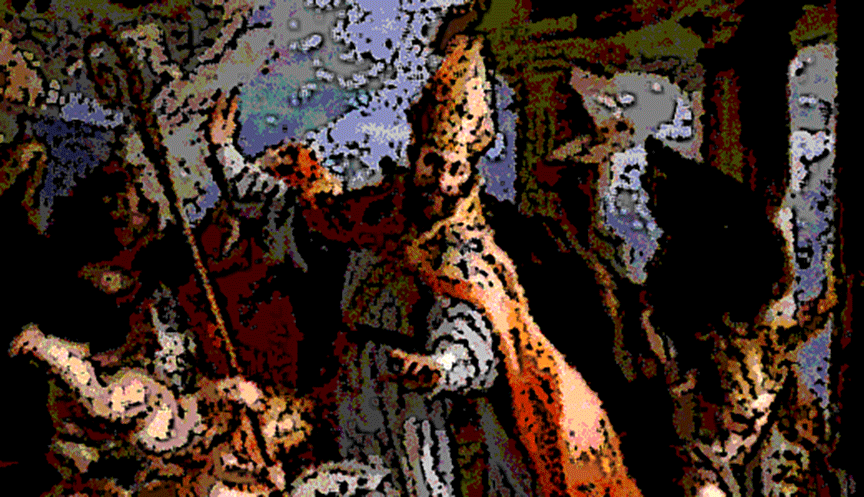
The History of the San Agustín Festival in Tucson
Homer Thiel discusses a long-celebrated late summer festival in Tucson, and how the tradition of the San Agustín Festival helped us make sense of a dense archaeological deposit near the Historic Pima County Courthouse in downtown Tucson.
During the Territorial Period (1856-1912), residents of Tucson celebrated three festivals. The San Ysidro Festival coincided with the wheat harvest in May. El Dia de San Juan Fiesta took place on June 24th and celebrated the forthcoming summer monsoon rains. Lastly, the San Agustín Festival honored the patron saint of Tucson, Augustine of Hippo. He was a bishop who lived in North Africa between AD 354 and 430. Tucsonans adopted his death date, August 28, to mark the beginning of the San Agustín Festival, coinciding with the harvest of fruits and other crops in Tucson.

Triunfo de San Agustín (Claudio Coello – https://bit.ly/3Bg2Urg, Public Domain, https://commons.wikimedia.org/w/index.php?curid=3949287)
The exact year the festival was first celebrated is unknown, but originated at the Presidio San Agustin del Tucson during either the Spanish (1694-1821) or Mexican (1821-1856) periods. On August 28, 1858, Samuel Heintzleman described it as being attended by about 200 or 300 people. A band consisting of a bass, a small drum, and one or two violins played. Another article stated that in 1874, a drum had been used for 25 years, suggesting the festival had been in existence at least since the late 1840s.
The festival began with a procession to the church, where a priest might give a sermon, and then people returned to the festival ground, where guns were fired and bells rung on their arrival. The festival ground originally was in the plaza inside the Tucson Presidio, but was moved to the east during the Territorial period (1856-1912), and eventually was moved back west to Levin’s park. An 1872 article from the Arizona Weekly Citizen describes the festival in the early Territorial period: “it has been the custom since the town was first built to commence the celebration on this day, and often continue it for ten or fifteen days; relations and friends for many miles around come to it to renew their old friendships and have a good time. The Feast is held on the public square, and a large circle is smoothed and covered in the center for dancing, and is generally in use from morning until late at night. Booths are erected on the outside where gaming is carried on and all kinds of refreshments are sold.” The booths each had a different name. In 1870 these included Watermelon, Summer-Green-Belly Wash, Critin, Whiskey, Pastry, Roast Pig and Chicken, Corner. Games included Cacraman, Keno, ABC, Chuck o ‘luck, Coffee pot, Rush Reubin, Window Glass, Monte, Tiger, Pescola, Chusetts, Rolette.
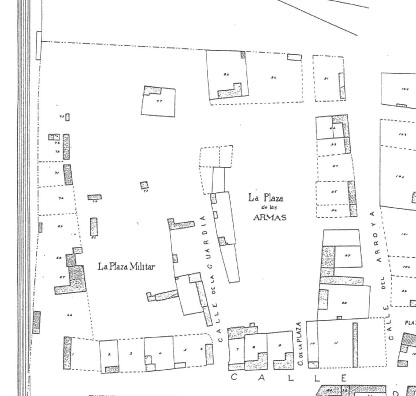
The 1862 Fergusson map of downtown Tucson depicts the area of the Presidio fortress. The San Agustín Festival took place in the Plaza de las Armas while the Presidio was still active. The recently excavated area, discussed below, is located along the dashed line on the north side of the plaza.
The booths were run by saloon owners, restaurateurs, confectioners, fruit sellers, cigar shop owners, and gamblers. Meals, alcohol, coffee, carbonated beverages, candy, and a variety of fruit including watermelon, grapes, and peaches could be purchased. Acorns (bellotas), called Arizona peanuts, were also available. Tamales and enchiladas were sold at some booths, while others offered ice cream and sweet cakes crusted with sugar. Foot races and horse races were popular. By 1880, fireworks were an added attraction, with one resembling a weeping willow and another described as looking like a fire fountain.
Newspapers reported that between 700 and 1,200 people visited the festival daily, with people of different ethnicity, social-economic status, and morality freely and happily intermingling. Newspaper accounts of the festival dwindle in the 1880s. In 1887, the Grand Feast of San Agustín was held at Carrillo’s Gardens. In 1890, Bavarian warblers sang songs, tamale vendors did well, and “Jimmie’s Wigwam is the most attractive places on the grounds.” The festival appears to have ceased soon afterward. Attempts have been made to revive it in the present day.
In 2019, Desert Archaeology excavated the area west of the 1929 Pima County Courthouse prior to the construction of the January 8th Memorial.
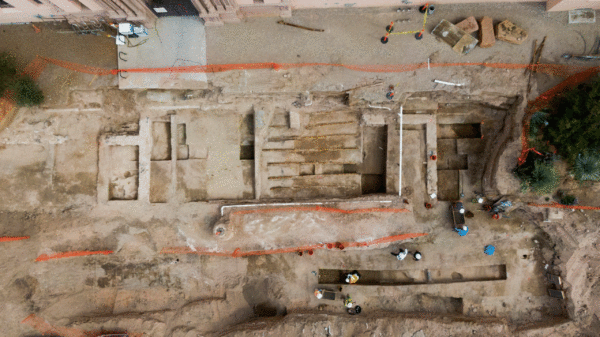
Drone photograph of the January 8th Memorial excavations (courtesy Randy Metcalf, Pima County Communications Office) (click to enlarge).
During the fieldwork, we located a thick later of Presidio-era trash. In one area an unusual layer, designated Feature 712, was encountered. The layer contained a lot of ash and charcoal, along with Native American ceramics and pieces of colorful Mexican majolica pottery. It also contained a large amount of animal bone and charred plant material. Dr. Michael Diehl‘s analysis of flotation samples and hand-collected plant materials resulted in the identification of barley or wheat, common bean, maize (corn), Arizona walnut, and peaches—the latter consisting of 112 peach pits, the oldest peaches identified to date in Tucson.
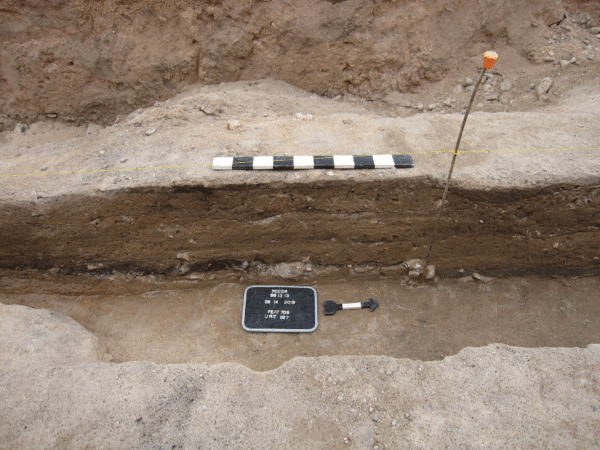
Feature 712 is the black layer on the left side, at the base of these excavation units. (click to enlarge)
Peaches are harvested in July and August in southern Arizona. In Tucson, fresh peaches were available in late August during the Territorial period. Maize is harvested from June through September. Fresh beans are harvested in June-July and October-November. Arizona walnuts fall from trees and are collected in mid-summer to early fall. Wheat is typically harvested during the summer months. Although all of these crops can be processed to preserve them for later consumption, the likelihood is that the foodstuffs in the Feature 712 layer were dumped sometime in July-August of an unknown year before 1856.
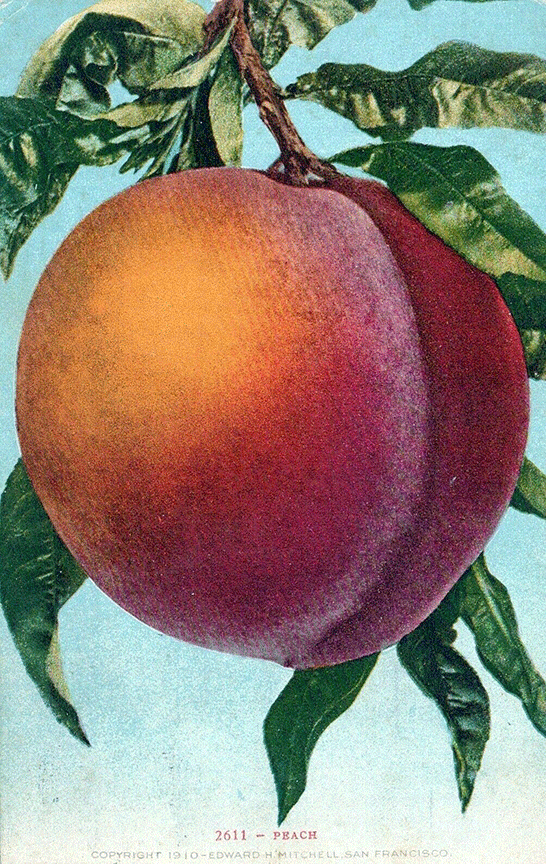
An antique postcard featuring a peach.
Jenny Waters identified a sample of the animal bones from the layer. Previous excavations had encountered many animal bones, with each sample dominated by cattle bones. The Feature 712 sample was different, with sheep bones dominating the collection, including skulls and horn cores from at least seven individuals. This was an unusual occurrence suggesting that a large number of sheep were butchered together at one time. Other bones in the sample came from four cattle, two chickens, a dog, a pig, a horse or mule, and a fork tail catfish. The latter may have been brought to Tucson as dried fish from Sonora, where that species of fish is found in rivers.
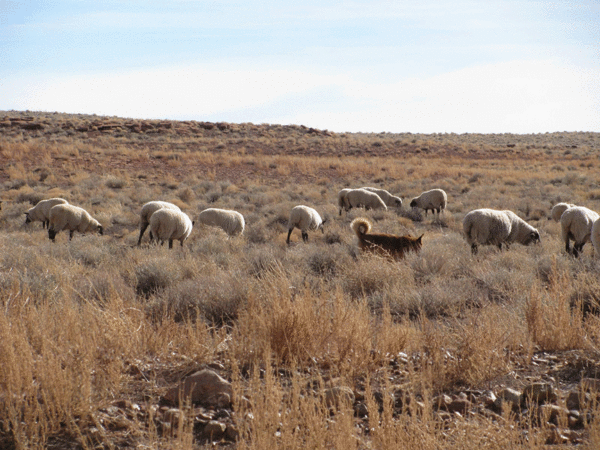
A herd of sheep guarded by a dog, photograph taken in northern Arizona.
Together, the plant and animal remains suggest that Feature 712 was deposited in late summer and was probably associated with a feasting event. The most likely explanation is that the layer is refuse discarded during the San Agustín Fiesta.
Resources
Pima County produced a video about the 2019 excavations.
The Library of Congress has scanned and made available many issues of early Tucson newspapers. These include the Weekly Arizonian (1868-1871), Arizona Citizen (1870-1880), Arizona Weekly Citizen (1880-1896), Arizona Daily Citizen (1900-1901), and El Fronterizo (1882-1908). They can be searched by name or keyword at https://chroniclingamerica.loc.gov/.


